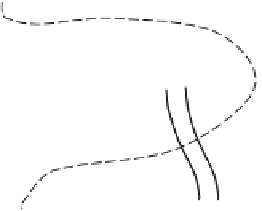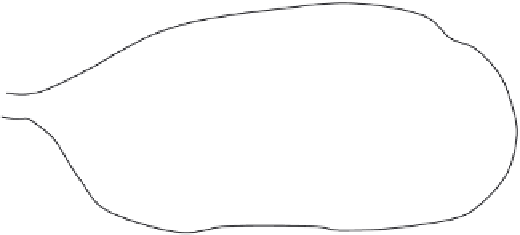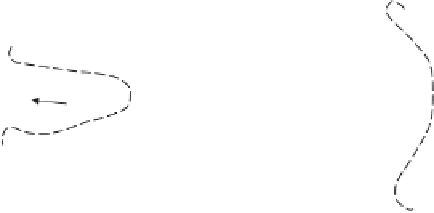Geoscience Reference
In-Depth Information
B
R
δ
s
s=0
stream
s=L
B
L
Fig. 10.29 Schematic plan view of a first-order catchment illustrating the integration of the local outflow rates
from the riparian unconfined aquifers to derive the total outflow from the area according to Equation
(10.152). The symbol
s
denotes the lineal coordinate along the river;
B
L
=
B
L
(
s
) and
B
R
=
B
R
(
s
)are
the breadths of the aquifers on the left and right banks, respectively; the dashed lines indicate the
height contour lines of the land surface.
of the basin, which can be considered as time invariant at the usual time scales of the
major components of the hydrologic cycle. The effect of the channel storage under
base flow conditions is normally quite small. Indeed, the water stored in river channels
is usually several orders of magnitude smaller than that stored in active groundwater
aquifers (see also Table 1.3). Moreover, typical travel times of water in a river tend
to be orders of magnitude smaller than those in the adjoining groundwater aquifers.
Under certain conditions, groundwater evaporation can have a seasonal effect; however,
because groundwater evaporation can take place only from limited areas, usually near
the river banks, where the water tables are close enough to the surface, this effect is often
negligible (see Zecharias and Brutsaert, 1988b).
From these considerations, it is apparent that the base flow at any point in the
river,
Q
Q
(
t
), is mainly the result of groundwater drainage; thus it can usually be
assumed to represent the instantaneous integral of all upstream local groundwater out-
flows, taken along the river channels all the way to the headwaters. With this assumption
the flow rate in a river at the outlet of a catchment under base flow conditions can be
formulated as
=
L
Q
(
t
)
=
(
|
q
L
| + |
q
R
|
)
ds
(10.152)
0
where
s
is the upstream lineal coordinate along all river channels in the basin,
L
is the total
length of these channels, and
q
L
=
t
) the groundwater inflows
from the left and the right bank, respectively (see Figure 10.29). Since the physiography
of the basin does not change with time, the local groundwater outflow rates
q
L
and
q
R
are
likely to be unique and time-invariant functions of the local groundwater storage. Because
q
L
and
q
R
depend on the coordinate
s
, Equation (10.152) indicates that the basin-scale
base flow
Q
(
t
) depends not only on the total water storage in the basin, but also on
the areal distribution of that storage over the basin. However, the storage distribution
does not always remain the same and it evolves, usually as a direct result of the spatial
q
L
(
s
,
t
) and
q
R
=
q
R
(
s
,










